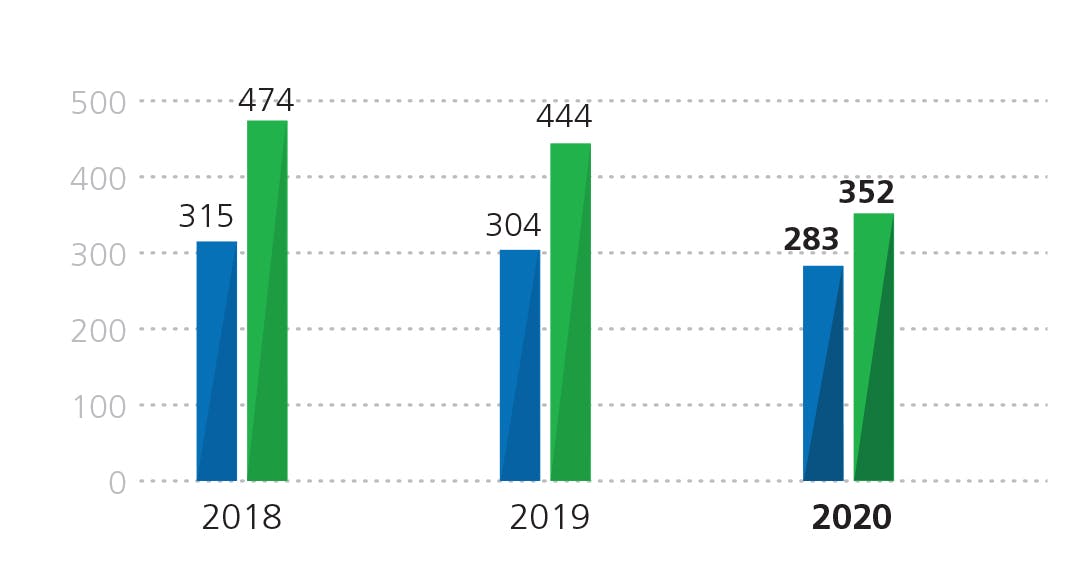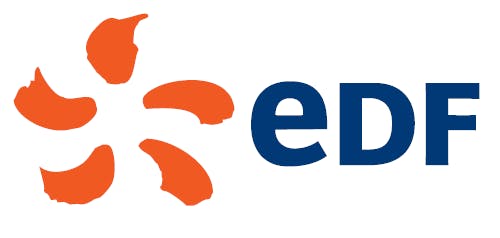3.2.4.3.3 Recycling in the field of new renewable energies
Recycling of wind turbines
Almost all the components of a wind turbine can be recycled, with the exception of the blades and permanent magnets. Composed essentially of concrete, steel/ castiron, copper and aluminium, the structure of a wind turbine is 90% recyclable. This figure rises to 98% if the concrete foundations are included. The hard-to-recycle components are the composite material blades. They represent about 10% of the weight of a wind turbine (2% when including the foundations). The most mature treatment solution for the moment is energy recovery. The recycling of wind turbine blades and components that are not currently recycled are the subject of various experiments and pilot projects on which EDF Renewables is working, in conjunction with EDF’s R&D. These include the upgrading of fibre glass blades and transformation into aggregates for integration into concrete or wood aggregate; reuse for street furniture, playgrounds or noise barriers; pyrolysis to recover glass or carbon fibres; new technologies for easily recyclable materials for future blades.
Rare-earth(1) elements pose a challenge for wind power, and only for technologies using permanent magnets, i.e. “PMG” (Permanent Magnet Generator) wind turbines.These may contain several rare-earth elements: neodymium, dysprosium, praseodymium, or sometimes terbium in their permanent magnets. Magnets represent on average 600 to 700kg/MW in Direct Drive (mainly used offshore), and 80 to 160kg/MW in Gearbox (mainly used onshore). Not all Direct Drive wind turbines contain rare-earth elements.
Due to the low volumes, there is not yet an industrial process for recycling permanent magnets in order to reuse rare-earth elements. The recycling of permanent magnets is under study and the first projects are emerging. Manufacturers are working on creating permanent magnet wind turbines without rare-earth elements.
Recycling of photovoltaic panels
In Europe, the recycling of photovoltaic panels is governed by the European “WEEE”(Waste Electrical and Electronic Equipment) Directive Suppliers are responsible for handling their end-of-life products. More than 95% of the components are recyclable and eco-organisations ensure collection and treatment. Rare-earth elements are not used in the manufacture of photovoltaic panels.
In France, PV Cycle provides end-of-life collection (the average eco-participation in the purchase of equipment is €0.70 per panel), and the first PV recycling plant opened in Rousset in 2018, recycling “crystalline silicon” panels. The materials are separated and redirected to various industrial sectors: silicon to precious metal sectors, the aluminium frame to aluminium refineries, glass in the glass sector, junction boxes and cables are crushed and sold as copper shot, and the plastic is used as recovery fuel in cement plants.
Outside the EU, EDF’s task is to contribute to the creation of recycling channels in the countries where the Group is present.
3.2.4.4 Assuming our responsibility for radioactive waste
3.2.4.4.1 Optimisation of radioactive waste
France has a strict legislative and regulatory framework that regulates the industrial management of radioactive waste and materials, stipulates any necessary add-on sand improvements, and secures financing of all these measures. The PNGMDR (French national radioactive materials and waste management plan) is a key part of this programme. Coordinated by the Ministry of Ecological Transition and the ASN (French Nuclear Safety Authority), the PNGMDR publishes guidelines on the management of radioactive materials and waste in France, and identifies any studies, actions and development work required on units or facilities. Stakeholders (including associations) are involved in this work.
For the first time, a public debate was held in 2019(2) to examine the 19-21PNGMDR (5th edition).
3.2.4.4.2 Radioactive Waste Management
EDF, which plays an active role in managing its waste, has set up an industrial operational waste and plant dismantling management programme, which already enables secure management of all waste from nuclear electrical generation, respecting both the environment and the health of local populations and staff alike. EDF is continuing to work to improve this programme to optimise this management. In particular, EDF endeavours to reduce the quantities and harmfulness of waste produced “at the source” through waste zoning design, optimisation and adjustment, defining and optimising soil and structural decontamination operations in accordance with ASN guides, and developing and promoting good operating practices, taking advantage of the PWR reactor unit fleet effect. In addition, Centraco’s fusion and incineration facilities help to further reduce stored waste volumes.
Waste from power plants in operation in France and the United Kingdom (electricity generation) is reflected here by two indicators: the volume of Low-Level solid radioactive waste disposed of (m3) for the United Kingdom and the volume of high-level and intermediate-level long-lived solid nuclear waste (m3) for France.
Volumes of solid radioactive waste (in m3)

2018 : France: volume of long-lived high and intermediate level solid radioactive waste (Key non-financial performance indicator) : 315, UK: volume of low level radioactive solid waste generated (Key non-financial performance indicator) : 474)
2019 : France: volume of long-lived high and intermediate level solid radioactive waste (Key non-financial performance indicator) : 304, UK: volume of low level radioactive solid waste generated (Key non-financial performance indicator) : 444
2020 : France: volume of long-lived high and intermediate level solid radioactive waste (Key non-financial performance indicator) : 283, UK: volume of low level radioactive solid waste generated (Key non-financial performance indicator) : 352
Key non-financial performance indicator
The methodology for this indicator is set out in detail in section 3.7.2.2"Details on performance indicators".
In France, the decrease in HA and MAVL radioactive waste production volumes is correlated with the decrease in fuel consumption over the year 2020 due to reduced electricity generation resulting from the impact of the Covid crisis. In the United Kingdom, the decline in very low level waste volumes reflects the drop in volumes shipped to approved channels due to the drop in activity also related to the health crisis.
In addition to the previous indicators, the generating plants in operation in France are concerned by very-low level solid radioactive waste and short-lived high-level and intermediate-level solid radioactive waste. The volume of very-low level waste in 2020 is 2,597m3, compared to 3,101m3 in 2019 and 3,289m3 in 2018. The volume of short-lived low-level and intermediate-level waste in 2020 is 5,429m3 compared to 5,734m3 in 2019 and 5,827m3 in 2018.
Within the Group’s scope in the United Kingdom, the intermediate-level radioactive waste generated was 161m3 in 2020, stable compared to 2019 and 2018.
(1) "Rare earths" are one of the categories of rare metals, a group of 17 metals whose chemical properties are necessary for the manufacture of high-tech devices. Other metals are considered "rare" or "critical" but are not "rare earths", for example cobalt or lithium.
(2) See section 1.4.1.1.2.3 “Nuclear issues” – “The nuclear fuel cycle”.
